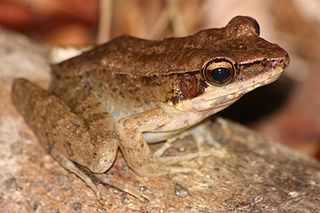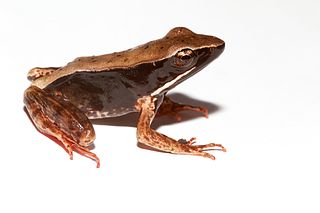
Papurana daemeli is a species of "true frog", family Ranidae. It is found in New Guinea, northern Australia, and some smaller islands. It is the only ranid frog found in Australia. In Australia, the species is restricted to the rainforest of northern Queensland and the eastern border of Arnhem Land, in the Northern Territory. In Australia, it is usually known as wood frog or sometimes as water frog. Other vernacular names are Australian wood frog, Australian bullfrog, and Arnhem rana.
Nyctimystes narinosus, the common big-eyed treefrog, is a species of frog in the family Pelodryadidae, or alternatively, subfamily Pelodryadinae in the family Hylidae. It is endemic to New Guinea and occurs in the Wahgi-Sepik Dividing Range and the Schrader Mountains, on both sides of the border between Papua (Indonesia) and Papua New Guinea. There is, however, some uncertainty about the western limit of this species. Despite its vernacular name, Nyctimystes narinosus is not a common species.
Copiula fistulans is a species of frog in the family Microhylidae. It is endemic to Papua New Guinea and occurs in the northeastern part of New Guinea in Morobe and Northern Provinces. Common name Lae Mehely frog has been coined for this species.

The Amami tip-nosed frog is a species of frog in the family Ranidae. It is endemic to the Amami Islands, a part of the Ryukyu Islands, Japan. Specifically, it is known from the islands of Amamioshima and Tokunoshima.
Odorrana supranarina is a species of frog in the family Ranidae. It is endemic to Ryukyu Archipelago, Japan, and is known from the islands of Ishigaki and Iriomote, both in the Yaeyama Group. The specific name supranarina refers to the large size of this species —at the time of the species description, it was the largest member of the so-called Rana narina complex. Common name greater tip-nosed frog has been coined for it.
Odorrana utsunomiyaorum is a species of frog in the family Ranidae. It is endemic to Ryukyu Archipelago, Japan, and is known from the islands of Ishigaki and Iriomote, both in the Yaeyama Group. The specific name utsunomiyaorum honours Taeko and Yasuaki Utsunomiya for their contributions to clarifying the amphibian fauna of the Yaeyama Group.

Warszewitsch's frog is a species of frog in the family Ranidae found in Honduras, Nicaragua, Costa Rica, and Panama.
Papurana arfaki is a species of true frog, family Ranidae. It is widely distributed in New Guinea and also found on the Aru Islands (Indonesia). Common names Arfak Mountains frog and large river-frog have been coined for it. Its type locality is the Arfak Mountains.
Papurana aurata is a species of true frogs, the family Ranidae. It is only known from the area of its type locality near Nabire, in the Indonesian province of Papua, in New Guinea. The specific name aurata is Latin and refers to the gold-like colour of adult males.
Chalcorana chalconota is a species of "true frog", family Ranidae. It is endemic to Indonesia and occurs in southern Sumatra, Java, Bali, and a few smaller islands. Populations previously assigned to this species now belong to a number of other Chalcorana species, leading to the current delineation of Chalcorana chalconota with a much narrower range. This species is also known as the Schlegel's frog, brown stream frog, copper-cheeked frog, or, among with many other species, white-lipped frog.

Sanguirana igorota is a species of true frog, family Ranidae. It is endemic to Cordillera Central of the island of Luzon, Philippines. Its closest relative is Sanguirana luzonensis, and it has even been considered synonym of that species; a later study suggests still unresolved relationships between S. igorota, S. luzonensis, and S. tipanan. Common name Taylor's Igorot frog has been coined for this species.
Papurana grisea is a species of true frog. It is known with certainty only from its type locality in the Went Mountains, in the Indonesian province of Papua, New Guinea. Similar frogs are widespread in New Guinea, usually above 1,200 m (3,900 ft) above sea level, as well as on the Seram Island, but their identity is uncertain; they possibly represent another, undescribed species. Common names Went Mountains frog and Montaen swamp frog have been coined for it.

Papurana kreffti is a species of true frog, family Ranidae. It is native to New Ireland and Buka Island and the Solomon Islands. The specific name kreffti honours Gerard Krefft, a German adventurer who settled in Australia and became there to be regarded as the father of Australian herpetology. Common names San Cristoval frog and San Cristobal treefrog have been coined for it.
Papurana milneana is a species of "true frog", family Ranidae. It is endemic to Papua New Guinea where it is found in the upland areas of Milne Bay, Morobe, Northern, and Central Provinces, as well from the D'Entrecasteaux Islands and, tentatively, Louisiade Archipelago. It was originally described as a subspecies of Rana grisea, but raised to full-species status in 2007.
Papurana novaeguineae is a species of true frog, family Ranidae. It is endemic to southern New Guinea and occurs between Lake Yamur and Purari River. Common name New Guinea frog has been coined for it.

Papurana papua is a species of true frog, family Ranidae. It is endemic to New Guinea and found in the northern part of the island in both Indonesia and Papua New Guinea as well in some offshore islands. Common name Papua frog has been coined for it.
Papurana supragrisea is a species of true frog, family Ranidae. It is endemic to New Guinea, including some nearby islands. It is known with certainty only from southeastern New Guinea and from the D'Entrecasteaux Islands. However, this name has been used more broadly for a species complex that is widely distributed in the mountains of New Guinea. Common name Papua gray frog has been coined for it.
Papurana volkerjane is a species of true frogs, family Ranidae. It is endemic to New Guinea and is known from its type locality, the eastern slopes of the Wondiwoi Mountains, from the Fakfak Mountains, and from the Bewani and Torricelli Mountainss in the West Sepik Province, Papua New Guinea. Rainer Günther named the species after his son Volker and daughter-in-law Jane.

Papurana waliesa is a species of "true frogs", family Ranidae. It is endemic to Papua New Guinea where it is found in the southern Owen Stanley Range and the Pini Range in the eastern New Guinea as well as in the D'Entrecasteaux Islands. The specific name waliesa is derived from the Dobu word waliesa that means "namesake", in honor of Fred Malesa from Fergusson Island. He had greatly assisted the describers of this species during their expedition in the Milne Bay Province.
Callulops eremnosphax is a species of frog in the family Microhylidae. It is endemic to Papua New Guinea and only known from its type locality near Tekadu Airport in the Gulf Province. The specific name eremnosphax is derived from Greek eremnos meaning "dark" and sphax meaning "throat".







